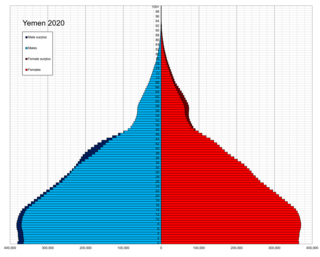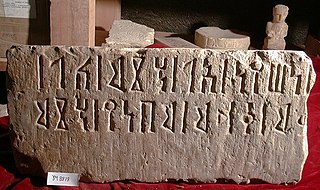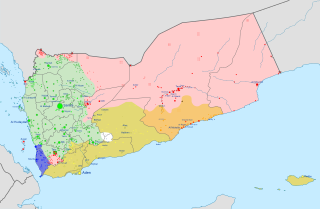Related Research Articles

Demographic features of the population of Yemen include population density, ethnicity, education level, health of the populace, economic status, religious affiliations and other aspects of the population.

The Arabian Peninsula, or Arabia, is a peninsula in West Asia, situated northeast of Africa on the Arabian Plate. At 3,237,500 km2 (1,250,000 sq mi), comparable in size to India, the Arabian Peninsula is the largest peninsula in the world.

The Arab world, formally the Arab homeland, also known as the Arab nation, the Arabsphere, or the Arab states, comprises a large group of countries, mainly located in West Asia and North Africa. While the majority of people in the Arab world are ethnically Arab, there are also significant populations of other ethnic groups such as Berbers, Kurds, Somalis and Nubians, among other groups. Arabic is used as the lingua franca throughout the Arab world.

Yemen, officially the Republic of Yemen, is a country in West Asia. Located in southern Arabia, it borders Saudi Arabia to the north, Oman to the northeast, the Red Sea to the west, and the Indian Ocean to the south, sharing maritime borders with Eritrea, Djibouti and Somalia across the Horn of Africa. Covering roughly 455,000 square kilometres, with a coastline of approximately 2,000 kilometres, Yemen is the second largest country on the Arabian Peninsula. Sanaa is its constitutional capital and largest city. Yemen's estimated population is 34.7 million, mostly Arab Muslims. It is a member of the Arab League, the United Nations, the Non-Aligned Movement and the Organisation of Islamic Cooperation.

Socotra or Saqatri is an island in the Indian Ocean part of Yemen. Lying between the Guardafui Channel and the Arabian Sea and near major shipping routes, Socotra is the largest of the six islands in the Socotra archipelago, which since 2013 constitutes one of Yemen's governorates.
Qoph is the nineteenth letter of the Semitic abjads, including Arabic qāfق, Aramaic qop 𐡒, Hebrew qūp̄ק, Phoenician qōp 𐤒, and Syriac qōp̄ ܩ.

The Ancient South Arabian script branched from the Proto-Sinaitic script in about the late 2nd millennium BCE. It was used for writing the Old South Arabian languages Sabaic, Qatabanic, Hadramautic, Minaean Hasaitic, and Geʽez in Dʿmt. The earliest instances of the Ancient South Arabian script are painted pottery sherds from Raybun in Hadhramaut in Yemen, which are dated to the late 2nd millennium BCE. There are no letters for vowels, though some can be indicated via matres lectionis.

The Houthi insurgency, also known as the Houthi rebellion, the Sa'dah Wars, or the Sa'dah conflict, was a military rebellion pitting Zaidi Shia Houthis against the Yemeni military that began in Northern Yemen and has since escalated into a full-scale civil war. The conflict was sparked in 2004 by the government's attempt to arrest Hussein Badreddin al-Houthi, a Zaidi religious leader of the Houthis and a former parliamentarian on whose head the government had placed a $55,000 bounty.
Judeo-Yemeni Arabic is a variety of Arabic spoken by Jews living or formerly living in Yemen. The language is quite different from mainstream Yemeni Arabic, and is written in the Hebrew alphabet. The cities of Sana'a, Aden, al-Bayda, and Habban District and the villages in their districts each have their own dialect.

Lesbian, gay, bisexual, transgender (LGBT) people in Yemen face legal challenges not experienced by non-LGBTQ residents. Same-sex sexual activity is punishable by death; this law is applied to both men and women. Members of the LGBT community additionally face stigmatization and homophobic violence among the broader population.

Liam Johnson Hendriks is an Australian professional baseball closing pitcher for the Boston Red Sox of Major League Baseball (MLB). He has previously played in MLB for the Minnesota Twins, Kansas City Royals, Toronto Blue Jays, Oakland Athletics and Chicago White Sox. He has been an All-Star three times and was the American League's Reliever of the Year in 2020 and 2021. His most recent accomplishment is winning the AL MLB Comeback Player of the Year Award for the 2023 season.
Himyaritic is an unattested or sparsely attested Semitic language that was spoken in ancient Yemen, by the Himyarite tribal confederacy. It was a Semitic language but either did not belong to the Old South Arabian (Sayhadic) languages according to Christian Robin or was, as more widely accepted, not a distinct language from Sabaic. The precise position inside Semitic is unknown because of the limited knowledge of the language if it is indeed a distinct language from Sabaic.
Levantine Arabic Sign Language is the sign language used by Deaf and hearing-impaired people of the area known as Bilad al-Sham or the Levant, comprising Jordan, Palestine, Syria, and Lebanon. Although there are significant differences in vocabulary between the four states, this is not much greater than regional differences within the states. Grammar is quite uniform and mutual intelligibility is high, indicating that they are dialects of a single language.
The Arab sign-language family is a family of sign languages spread across the Arab Middle East. Its extent is not yet known, because only some of the sign languages in the region have been compared.
Libyan Sign Language is the deaf sign language of Libya. It appears to belong to the Arab sign language family.
Kuwaiti Sign Language is the deaf sign language of Kuwait. It appears to belong to the Arab sign language family.
Iraqi Sign Language is the deaf sign language of Iraq. It appears to be close to Levantine Arabic Sign Language the common sign language of Lebanon, Palestine, Syria, and Jordan. It is taught in seven schools or deaf associations in the capital of Baghdad and 5 other cities.
Yemeni hip hop is a Yemeni music style and cultural movement related to rap and hip hop culture. It has influences from American hip hop and also from traditional music from the region. It is usually considered to have emerged from mid-2000s and reached its consolidation by 2009 when the first public concert was held in the French Cultural Institute. Although it has a variety of themes, there was an intense production of political songs by the Yemeni Revolution.

Hendrik Hoppenstedt is a German politician of the Christian Democratic Union (CDU) who has been serving as a member of the German parliament Bundestag since 2013, representing the Hannover-Land I constituency. Before he got elected in 2013, he was mayor of the city of Burgwedel in the northern German state of Lower Saxony.